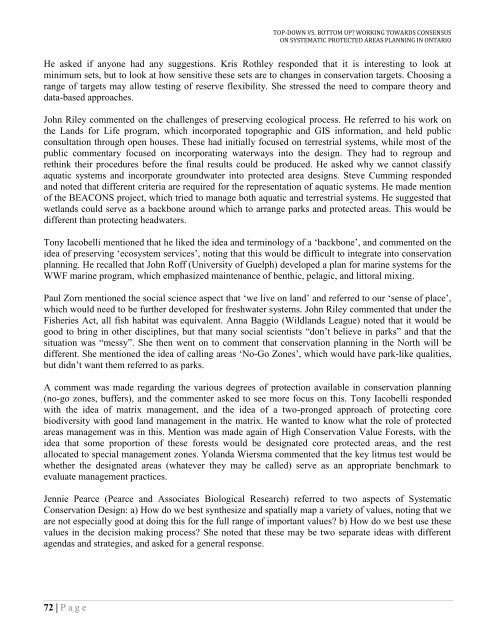Top-Down vs. Bottom Up: Working Towards Consensus ... - CASIOPA
Top-Down vs. Bottom Up: Working Towards Consensus ... - CASIOPA
Top-Down vs. Bottom Up: Working Towards Consensus ... - CASIOPA
- No tags were found...
Create successful ePaper yourself
Turn your PDF publications into a flip-book with our unique Google optimized e-Paper software.
TOP-DOWN VS. BOTTOM UP? WORKING TOWARDS CONSENSUSON SYSTEMATIC PROTECTED AREAS PLANNING IN ONTARIOHe asked if anyone had any suggestions. Kris Rothley responded that it is interesting to look atminimum sets, but to look at how sensitive these sets are to changes in conservation targets. Choosing arange of targets may allow testing of reserve flexibility. She stressed the need to compare theory anddata-based approaches.John Riley commented on the challenges of preserving ecological process. He referred to his work onthe Lands for Life program, which incorporated topographic and GIS information, and held publicconsultation through open houses. These had initially focused on terrestrial systems, while most of thepublic commentary focused on incorporating waterways into the design. They had to regroup andrethink their procedures before the final results could be produced. He asked why we cannot classifyaquatic systems and incorporate groundwater into protected area designs. Steve Cumming respondedand noted that different criteria are required for the representation of aquatic systems. He made mentionof the BEACONS project, which tried to manage both aquatic and terrestrial systems. He suggested thatwetlands could serve as a backbone around which to arrange parks and protected areas. This would bedifferent than protecting headwaters.Tony Iacobelli mentioned that he liked the idea and terminology of a „backbone‟, and commented on theidea of preserving „ecosystem services‟, noting that this would be difficult to integrate into conservationplanning. He recalled that John Roff (University of Guelph) developed a plan for marine systems for theWWF marine program, which emphasized maintenance of benthic, pelagic, and littoral mixing.Paul Zorn mentioned the social science aspect that „we live on land‟ and referred to our „sense of place‟,which would need to be further developed for freshwater systems. John Riley commented that under theFisheries Act, all fish habitat was equivalent. Anna Baggio (Wildlands League) noted that it would begood to bring in other disciplines, but that many social scientists “don‟t believe in parks” and that thesituation was “messy”. She then went on to comment that conservation planning in the North will bedifferent. She mentioned the idea of calling areas „No-Go Zones‟, which would have park-like qualities,but didn‟t want them referred to as parks.A comment was made regarding the various degrees of protection available in conservation planning(no-go zones, buffers), and the commenter asked to see more focus on this. Tony Iacobelli respondedwith the idea of matrix management, and the idea of a two-pronged approach of protecting corebiodiversity with good land management in the matrix. He wanted to know what the role of protectedareas management was in this. Mention was made again of High Conservation Value Forests, with theidea that some proportion of these forests would be designated core protected areas, and the restallocated to special management zones. Yolanda Wiersma commented that the key litmus test would bewhether the designated areas (whatever they may be called) serve as an appropriate benchmark toevaluate management practices.Jennie Pearce (Pearce and Associates Biological Research) referred to two aspects of SystematicConservation Design: a) How do we best synthesize and spatially map a variety of values, noting that weare not especially good at doing this for the full range of important values? b) How do we best use thesevalues in the decision making process? She noted that these may be two separate ideas with differentagendas and strategies, and asked for a general response.72 | P a g e


